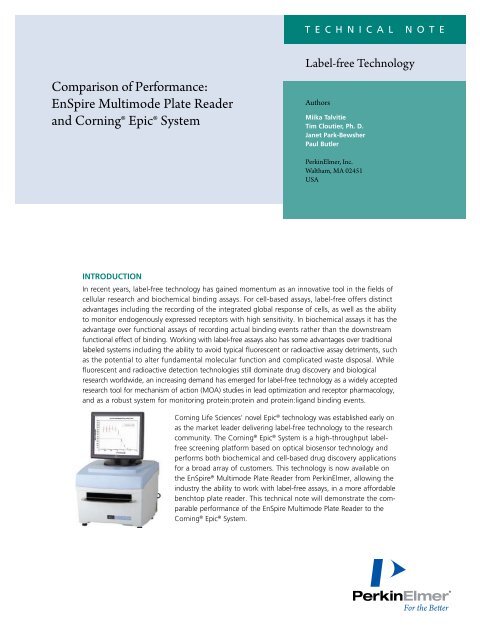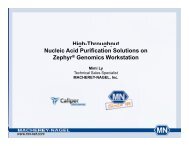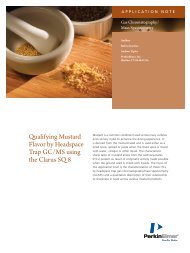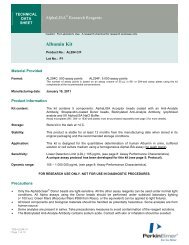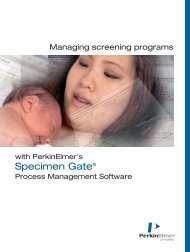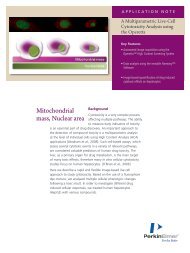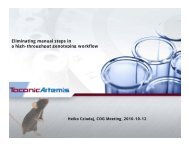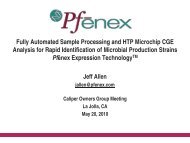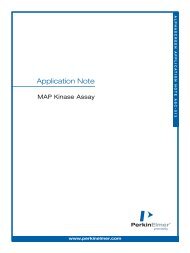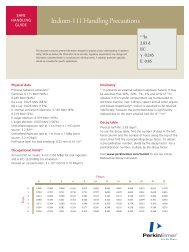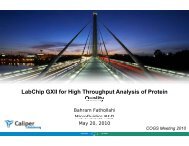Comparison of Performance: EnSpire Multimode Plate ... - PerkinElmer
Comparison of Performance: EnSpire Multimode Plate ... - PerkinElmer
Comparison of Performance: EnSpire Multimode Plate ... - PerkinElmer
Create successful ePaper yourself
Turn your PDF publications into a flip-book with our unique Google optimized e-Paper software.
Technical Note<br />
<strong>Comparison</strong> <strong>of</strong> <strong>Performance</strong>:<br />
<strong>EnSpire</strong> <strong>Multimode</strong> <strong>Plate</strong> Reader<br />
and Corning® Epic® System<br />
Label-free Technology<br />
Authors<br />
Miika Talvitie<br />
Tim Cloutier, Ph. D.<br />
Janet Park-Bewsher<br />
Paul Butler<br />
<strong>PerkinElmer</strong>, Inc.<br />
Waltham, MA 02451<br />
USA<br />
Introduction<br />
In recent years, label-free technology has gained momentum as an innovative tool in the fields <strong>of</strong><br />
cellular research and biochemical binding assays. For cell-based assays, label-free <strong>of</strong>fers distinct<br />
advantages including the recording <strong>of</strong> the integrated global response <strong>of</strong> cells, as well as the ability<br />
to monitor endogenously expressed receptors with high sensitivity. In biochemical assays it has the<br />
advantage over functional assays <strong>of</strong> recording actual binding events rather than the downstream<br />
functional effect <strong>of</strong> binding. Working with label-free assays also has some advantages over traditional<br />
labeled systems including the ability to avoid typical fluorescent or radioactive assay detriments, such<br />
as the potential to alter fundamental molecular function and complicated waste disposal. While<br />
fluorescent and radioactive detection technologies still dominate drug discovery and biological<br />
research worldwide, an increasing demand has emerged for label-free technology as a widely accepted<br />
research tool for mechanism <strong>of</strong> action (MOA) studies in lead optimization and receptor pharmacology,<br />
and as a robust system for monitoring protein:protein and protein:ligand binding events.<br />
Corning Life Sciences' novel Epic ® technology was established early on<br />
as the market leader delivering label-free technology to the research<br />
community. The Corning ® Epic ® System is a high-throughput labelfree<br />
screening platform based on optical biosensor technology and<br />
performs both biochemical and cell-based drug discovery applications<br />
for a broad array <strong>of</strong> customers. This technology is now available on<br />
the <strong>EnSpire</strong> ® <strong>Multimode</strong> <strong>Plate</strong> Reader from <strong>PerkinElmer</strong>, allowing the<br />
industry the ability to work with label-free assays, in a more affordable<br />
benchtop plate reader. This technical note will demonstrate the comparable<br />
performance <strong>of</strong> the <strong>EnSpire</strong> <strong>Multimode</strong> <strong>Plate</strong> Reader to the<br />
Corning ® Epic ® System.
MATERIALS AND METHODS<br />
<strong>Plate</strong> readers and detection technology<br />
The Corning ® Epic ® System is a high-throughput label-free<br />
screening platform using patented optical biosensor technology.<br />
The <strong>EnSpire</strong> combines the Epic ® System's optical biosensor<br />
technology with traditional measurement technologies such<br />
as fluorescence, ultra-sensitive luminescence, and patented<br />
Alpha technology in a single benchtop unit. A resonant waveguide<br />
grating biosensor is incorporated into the bottom <strong>of</strong> each<br />
well <strong>of</strong> the proprietary label-free microplate. The <strong>EnSpire</strong> with<br />
label-free technology has a dedicated light source for exciting the<br />
microplate bottom. The <strong>EnSpire</strong> measures changes in local<br />
index <strong>of</strong> refraction. In cellular assays, these changes result<br />
from the ligand induced dynamic mass redistribution (DMR)<br />
within the bottom region (~150 nm) <strong>of</strong> the cell monolayer<br />
(cell-based assays). Binding events, such as an antigen binding<br />
to an antibody, create mass change in biochemical<br />
assays. These changes are detected as a picometer (pm)<br />
shift in the wavelength <strong>of</strong> the reflected light from the<br />
microplate. The peak position <strong>of</strong> the reflected wavelength<br />
spectrum is detected and analyzed using a spectrometer<br />
within the label-free technology module. The assay plates are<br />
measured before (the baseline read) and after (the final read)<br />
compound/sample addition. The results are reported as<br />
response (pm) showing the picometer shift between final and<br />
baseline reads. Response indicates DMR and mass changes<br />
in cell-based and biochemical assays, respectively.<br />
Reagents for cell-based and biochemical assays<br />
For reagents and detailed assay protocols see application<br />
notes 009449_01 and 009450_01.<br />
Microplates<br />
For cell-based assay protocols: <strong>EnSpire</strong>-LFC, 384-well (with<br />
fibronectin coating) microplates (Catalogue No. 6057428).<br />
For biochemical assay protocols: <strong>EnSpire</strong>-LFB, 384-well (with<br />
amine-coupling) microplates (Catalogue No. 6057418).<br />
Cell-based label-free assay protocol:<br />
1. Cell culturing & seeding to label-free plates<br />
2. Buffer exchange (wash plate 3x)<br />
3. Preparation <strong>of</strong> compound plates<br />
4. Baseline measurement (4x)<br />
5. Compound (antagonist) addition, 10 µl<br />
6. Final reading, 30 repeats (antagonist read)<br />
7. Compound (agonist) addition, 10 µl<br />
8. 2nd Final read, 30 repeats (agonist read)<br />
9. Data analysis using <strong>EnSpire</strong> s<strong>of</strong>tware and<br />
GraphPad PRISM ®<br />
Biochemical label-free assay protocol:<br />
1. Immobilization <strong>of</strong> protein<br />
2. Buffer exchange, thermal equilibration 4 hours<br />
3. Preparation <strong>of</strong> compound into label-free plates<br />
4. Baseline measurement (4x)<br />
5. Compound addition<br />
6. Final reading, 4 repeats (antagonist read)<br />
7. Data analysis using <strong>EnSpire</strong> s<strong>of</strong>tware and<br />
GraphPad PRISM ®<br />
Label-free Assay Principles<br />
GPCRs<br />
Cell<br />
Surface Coating<br />
Chemistry<br />
GPCRs<br />
Analytes<br />
Cell<br />
Surface Coating<br />
Dynamic Mass<br />
Redistribution<br />
Chemistry<br />
Targets<br />
Analytes<br />
Chemistry<br />
Targets<br />
Analytes<br />
Chemistry<br />
Targets<br />
Substrate<br />
Substrate<br />
Substrate<br />
Substrate<br />
Substrate<br />
Sample<br />
Reference<br />
Sample<br />
Reference<br />
Sample<br />
Reference<br />
Broadband<br />
Source<br />
Baseline<br />
Measurements<br />
Reflected<br />
Wavelength<br />
Broadband<br />
Source<br />
Signal<br />
Measurements<br />
Reflected<br />
Wavelength<br />
Broadband<br />
Source<br />
Reflected<br />
Wavelength<br />
Broadband<br />
Source<br />
Reflected<br />
Wavelength<br />
Cell-based assays<br />
Step 1: Grow cells overnight to get baseline measurement<br />
Step 2: Add compound and measure signals<br />
Biochemical assays<br />
Step 1: Target is immobilized on the microplate amine-coupling surface<br />
Step 2: Reference area prevents non-specific target immobilization followed by the washing and<br />
baseline read, and the addition <strong>of</strong> the analyte<br />
Step 3: Analyte is bound to allow for final read<br />
2
Data analysis<br />
The integrated data analysis tools on the <strong>EnSpire</strong> were<br />
used to analyze the DMR (cell-based assay) and mass change<br />
(biochemical assay), and to generate dose response curves<br />
and subsequent calculations <strong>of</strong> EC/IC 50<br />
.<br />
The following calculations were used to generate<br />
Response (pm) and EC/IC 50<br />
values:<br />
DISCUSSION<br />
Label-free data obtained from cell-based and biochemical<br />
assays initiated on both platforms, suggest the performance<br />
<strong>of</strong> the <strong>EnSpire</strong> should be comparable to that <strong>of</strong> the Corning ®<br />
Epic ® System for these types <strong>of</strong> assays. Moreover, the data<br />
implies that current users <strong>of</strong> the Corning ® Epic ® System can<br />
expect comparable results when deploying their label-free<br />
applications on the <strong>EnSpire</strong>.<br />
1) Response (pm)<br />
2) Response for selected plate selected repeat number. This<br />
calculation uses the result from the previous calculation<br />
as an input.<br />
3) Generates dose response curves and reports EC/IC 50<br />
values.<br />
This calculation uses the result from the previous calculation<br />
as an input.<br />
RESULTS<br />
Response (pm)<br />
300<br />
250<br />
200<br />
150<br />
100<br />
50<br />
0<br />
-50<br />
Carbachol Agonist Dose Response On Endogenous M 1<br />
in HEK 293 Cells On Epic ® vs. <strong>EnSpire</strong> Label-free Instrument<br />
-12 -10 -8 -6 -4 -2<br />
Log [Ligand] (M)<br />
<strong>EnSpire</strong>-Label-Free (Carbachol)<br />
Epic (Carbachol)<br />
Instrument EC 50 *<br />
<strong>EnSpire</strong> Label-free 5.9<br />
Epic ® 5.3<br />
*EC 50 in µM<br />
Response (pm)<br />
250<br />
200<br />
150<br />
100<br />
50<br />
0<br />
Agonist Z' Calculations Of Endogenous M 1<br />
in<br />
HEK293 Cells On <strong>EnSpire</strong> Label-free Platform<br />
Z' = 0.78<br />
-50<br />
0 10 20 30<br />
Well<br />
Carbachol<br />
Buffer<br />
Figure 1 shows excellent correlation <strong>of</strong> the dose response pr<strong>of</strong>iles, as well as closely<br />
matched EC 50<br />
values for the cell-based assay.<br />
Response (pm)<br />
60<br />
40<br />
20<br />
Streptavidin-Biotin Dose Response On<br />
Epic ® vs. <strong>EnSpire</strong> Label-free Platform<br />
<strong>EnSpire</strong>-Label-Free SA-Biotin<br />
Epic SA-Biotin<br />
Instrument EC 50 *<br />
<strong>EnSpire</strong> Label-free 367<br />
Epic ® 366<br />
*EC 50 in nM<br />
Response (pm)<br />
Agonist Z' Calculations Of Endogenous M 1<br />
in<br />
HEK293 Cells On Epic<br />
250<br />
200<br />
150<br />
100<br />
50<br />
0<br />
Z' = 0.84<br />
Carbachol<br />
Buffer<br />
0<br />
-11 -10 -9 -8 -7 -6 -5 -4<br />
Log [Biotin] (M)<br />
-50<br />
0 10 20 30 40<br />
Well<br />
Figure 2 shows almost identical dose response pr<strong>of</strong>iles, as well as almost identical<br />
EC 50<br />
values for the biochemical assay.<br />
Figure 3 shows Z' values <strong>of</strong> 0.78 and 0.84 for the <strong>EnSpire</strong> label-free platform and<br />
Corning® Epic® platform respectively (i.e. cell-based assay) and demonstrates<br />
similar reproducibility <strong>of</strong> both systems.<br />
3
<strong>PerkinElmer</strong>, Inc.<br />
940 Winter Street<br />
Waltham, MA 02451 USA<br />
P: (800) 762-4000 or<br />
(+1) 203-925-4602<br />
www.perkinelmer.com<br />
For a complete listing <strong>of</strong> our global <strong>of</strong>fices, visit www.perkinelmer.com/ContactUs<br />
Copyright ©2010-2011, <strong>PerkinElmer</strong>, Inc. All rights reserved. <strong>PerkinElmer</strong> ® is a registered trademark <strong>of</strong> <strong>PerkinElmer</strong>, Inc. Corning and Epic are registered trademarks <strong>of</strong> Corning Incorporated. All other trademarks are the property <strong>of</strong> their<br />
respective owners.<br />
009446A_01 Printed in USA Jan. 2011


